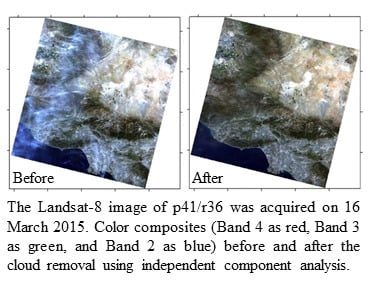Removal of Thin Clouds in Landsat-8 OLI Data with Independent Component Analysis
Abstract
:1. Introduction
2. Methodology
2.1. An Algorithm to Remove Clouds Using ICA
2.2. Algorithm Assessment
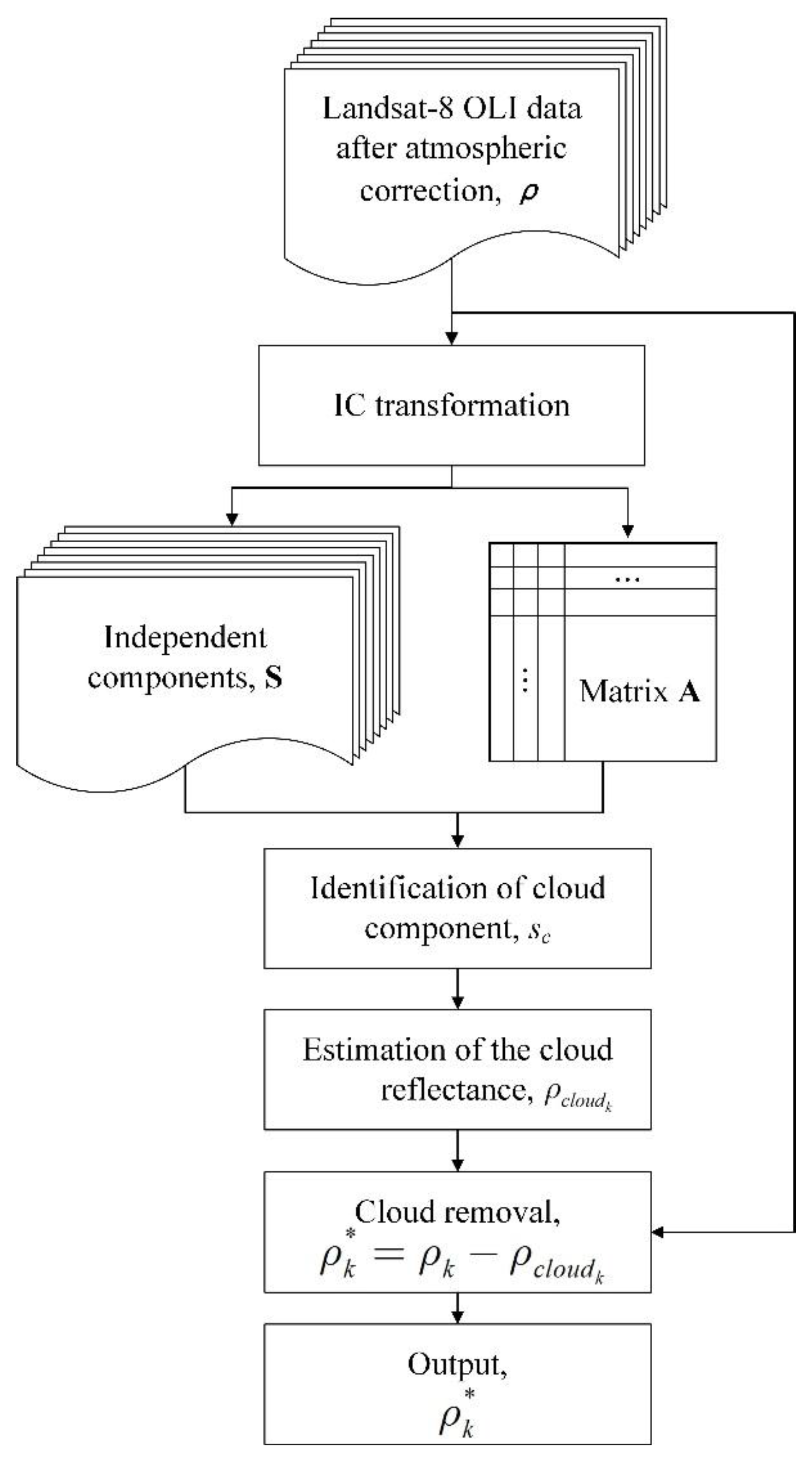
2.3. Study Area and Landsat-8 Datasets
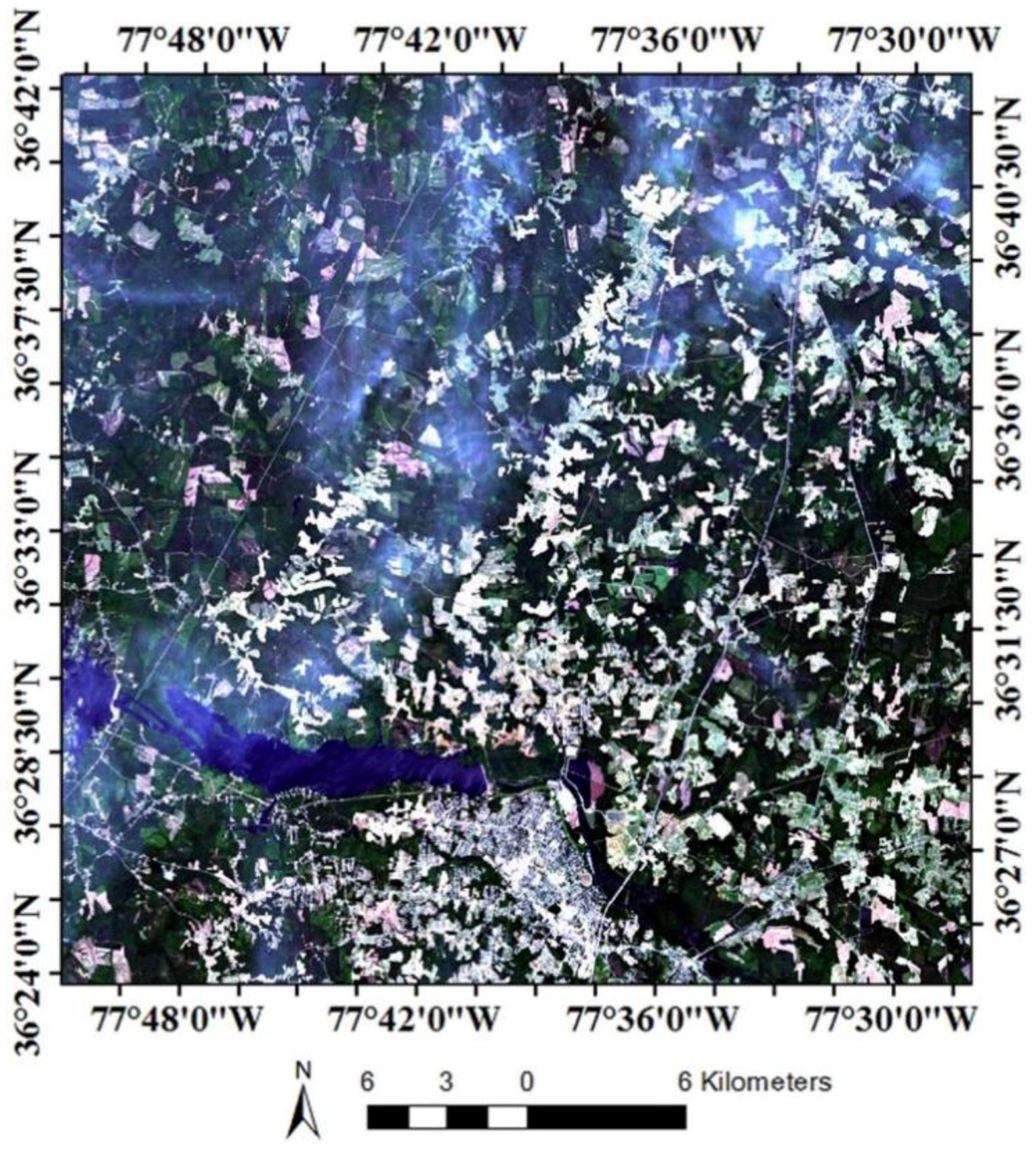
3. Results and Discussions
3.1. Cloud Correction
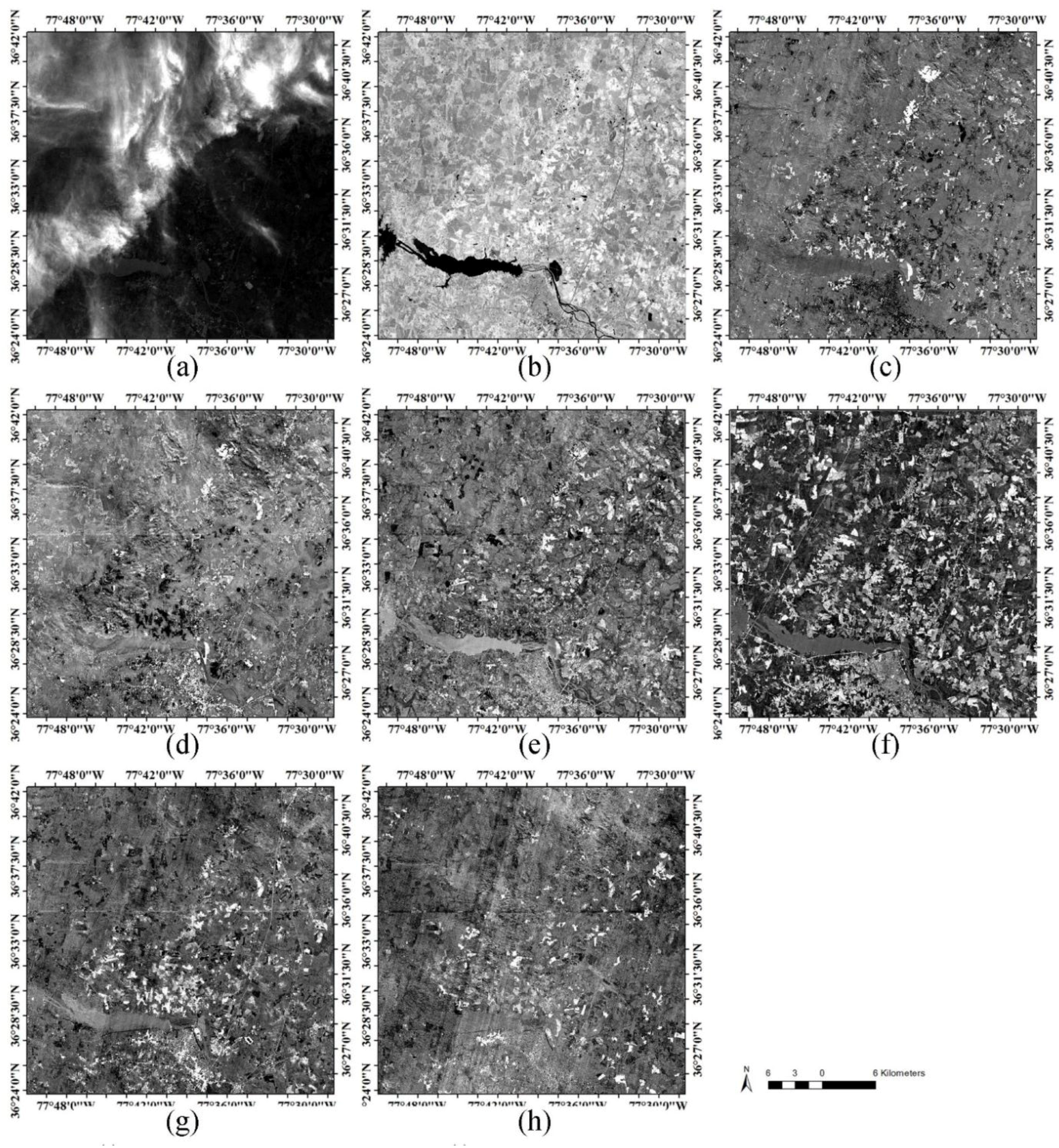
| s1 | s2 | s3 | s4 | s5 | s6 | s7 | s8 | |
|---|---|---|---|---|---|---|---|---|
| Band 1 | 0.903 | 0.394 | 0.321 | –0.023 | 1.217 | 1.033 | 0.554 | 1.170 |
| Band 2 | 0.795 | 0.635 | 0.426 | 0.025 | 1.248 | 1.209 | 0.662 | 1.211 |
| Band 3 | 0.594 | 0.674 | 1.112 | 0.434 | 1.440 | 1.742 | 1.182 | 1.295 |
| Band 4 | 0.542 | 1.398 | 1.046 | 1.028 | 1.972 | 2.497 | 1.132 | 1.371 |
| Band 5 | –0.870 | –1.602 | 8.079 | –0.240 | –0.026 | –1.267 | –0.185 | 0.772 |
| Band 6 | –0.491 | 1.832 | 4.525 | 0.404 | 2.055 | 5.996 | 0.519 | 0.809 |
| Band 7 | –0.134 | 1.819 | 2.401 | 0.295 | 2.395 | 4.310 | 0.961 | 0.376 |
| Band 9 | 0.496 | –0.036 | 0.030 | 0.021 | –0.019 | –0.016 | –0.011 | –0.010 |
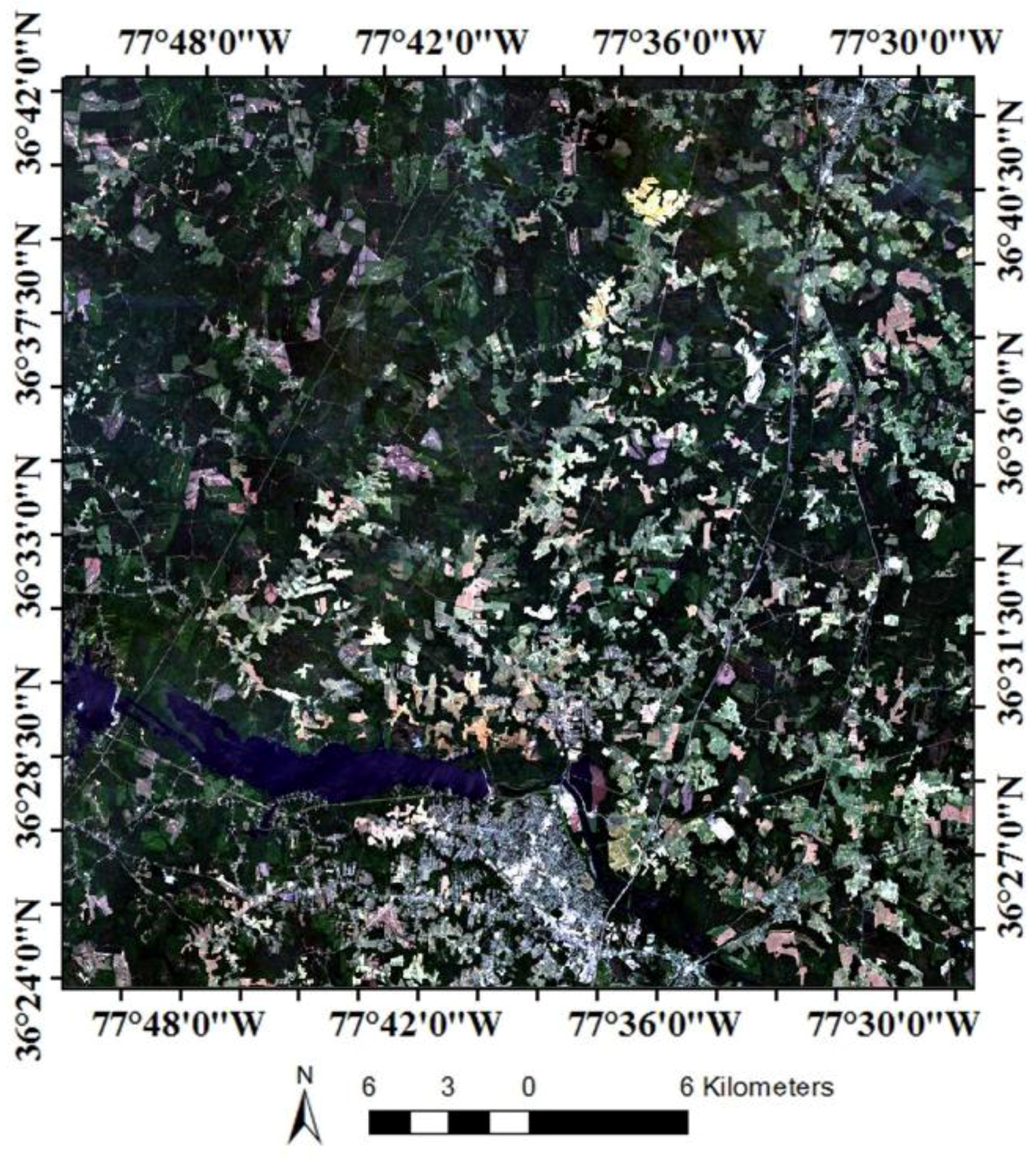
3.2. Assessment
3.2.1. Cloud and Cloud-Free Masks
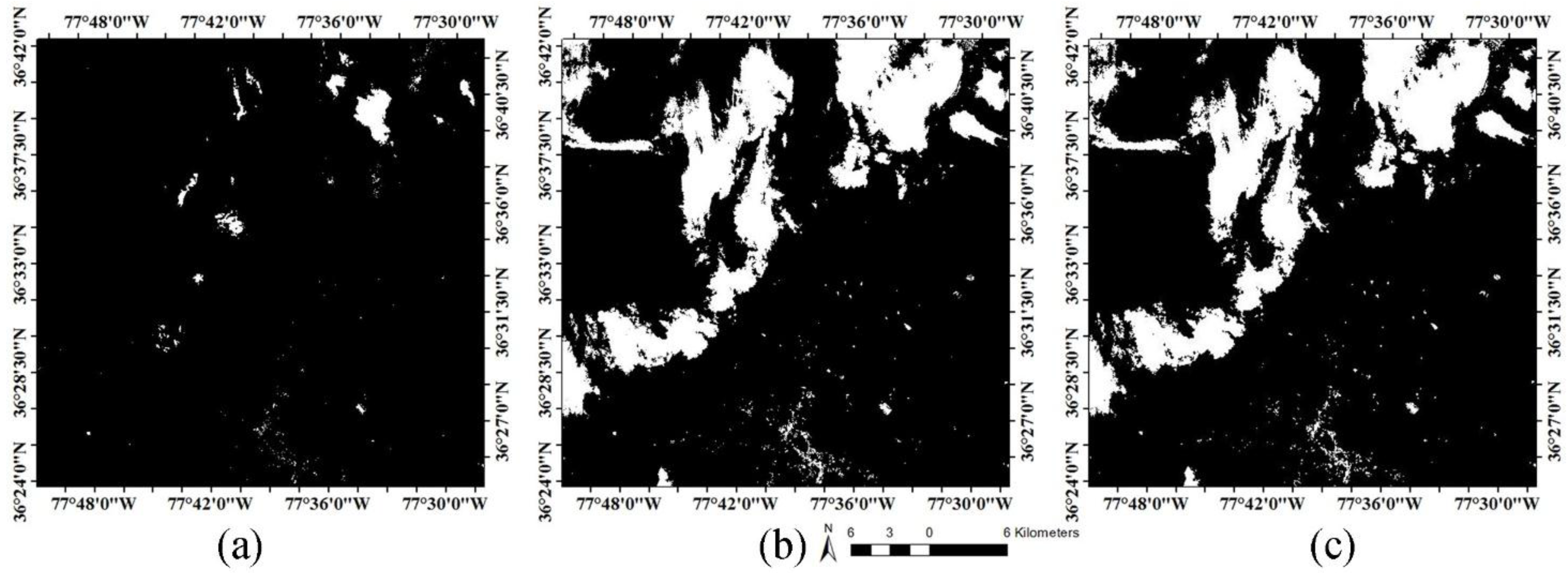
3.2.2. Assessment in Cloud-Covered Areas
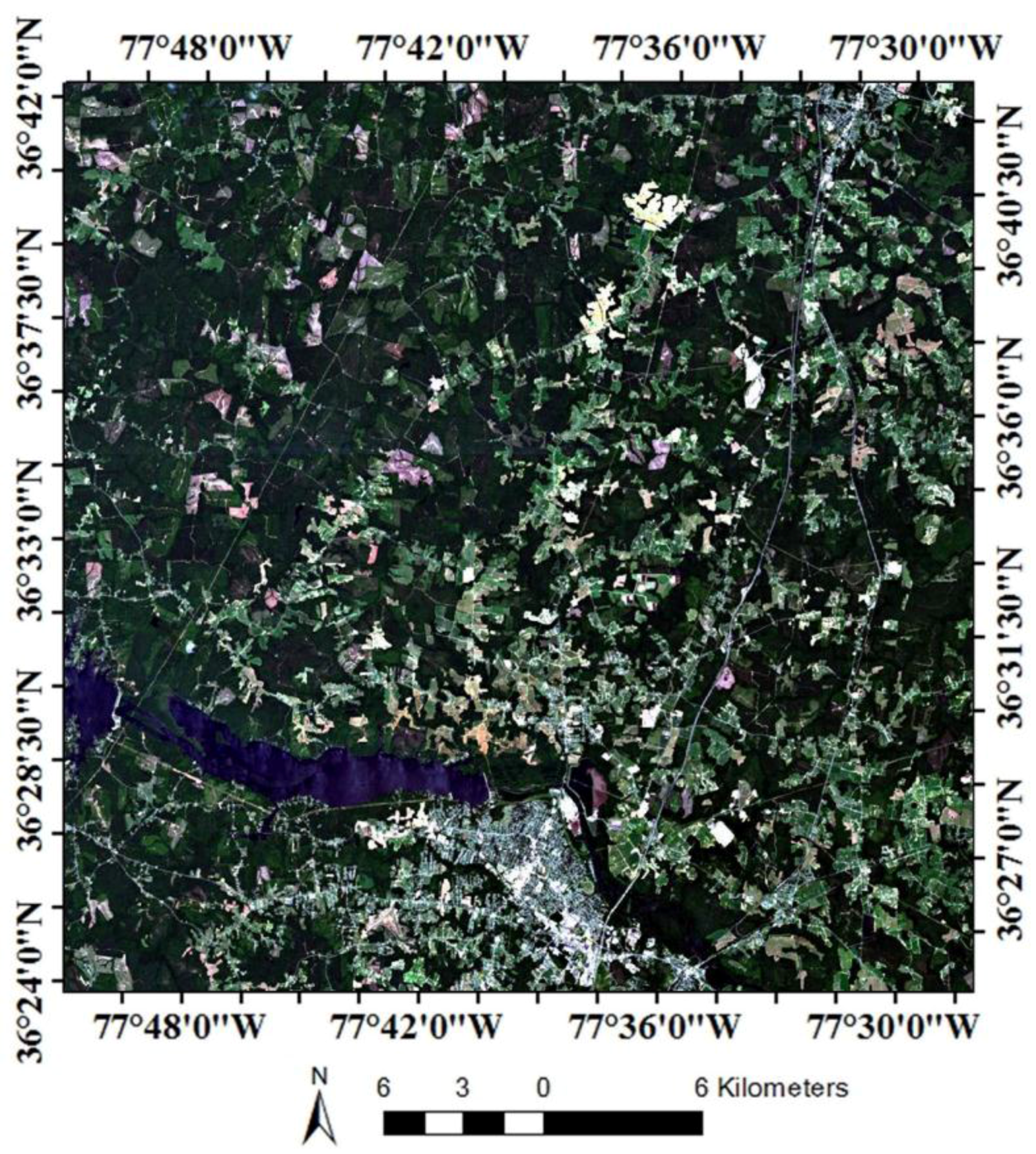
| Slope | Intercept | R2 | ||||
|---|---|---|---|---|---|---|
| Before | After | Before | After | Before | After | |
| Band 1 | 0.624 | 1.038 | 0.001 | 0.001 | 0.965 | 0.977 |
| Band 2 | 0.745 | 1.095 | –0.012 | –0.005 | 0.968 | 0.982 |
| Band 3 | 1.182 | 1.303 | –0.027 | –0.015 | 0.963 | 0.983 |
| Band 4 | 1.034 | 1.178 | –0.023 | –0.012 | 0.976 | 0.989 |
| Band 5 | 1.249 | 1.238 | –0.042 | –0.054 | 0.922 | 0.933 |
| Band 6 | 1.160 | 1.151 | –0.045 | –0.030 | 0.967 | 0.955 |
| Band 7 | 1.143 | 1.138 | –0.023 | –0.019 | 0.974 | 0.969 |

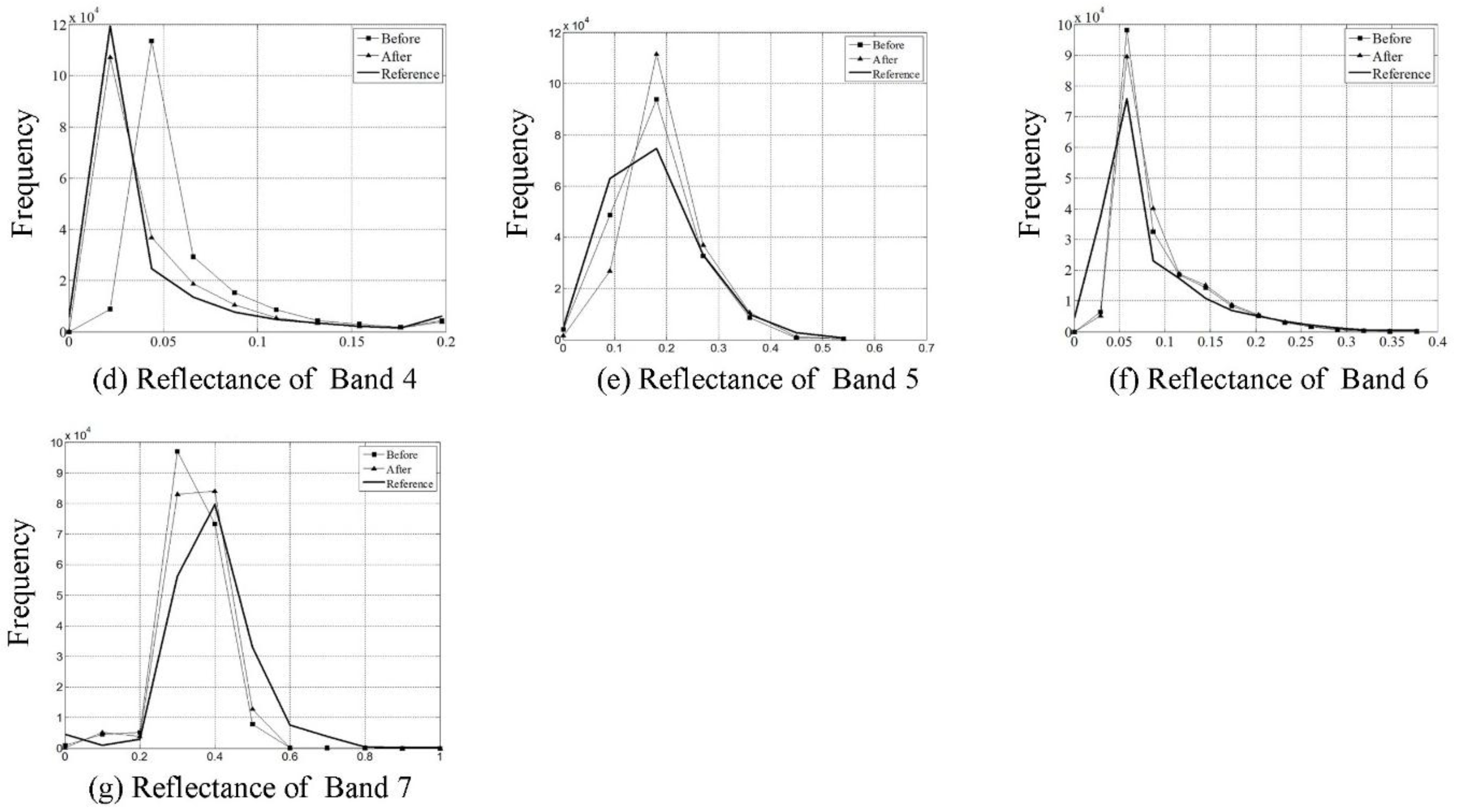
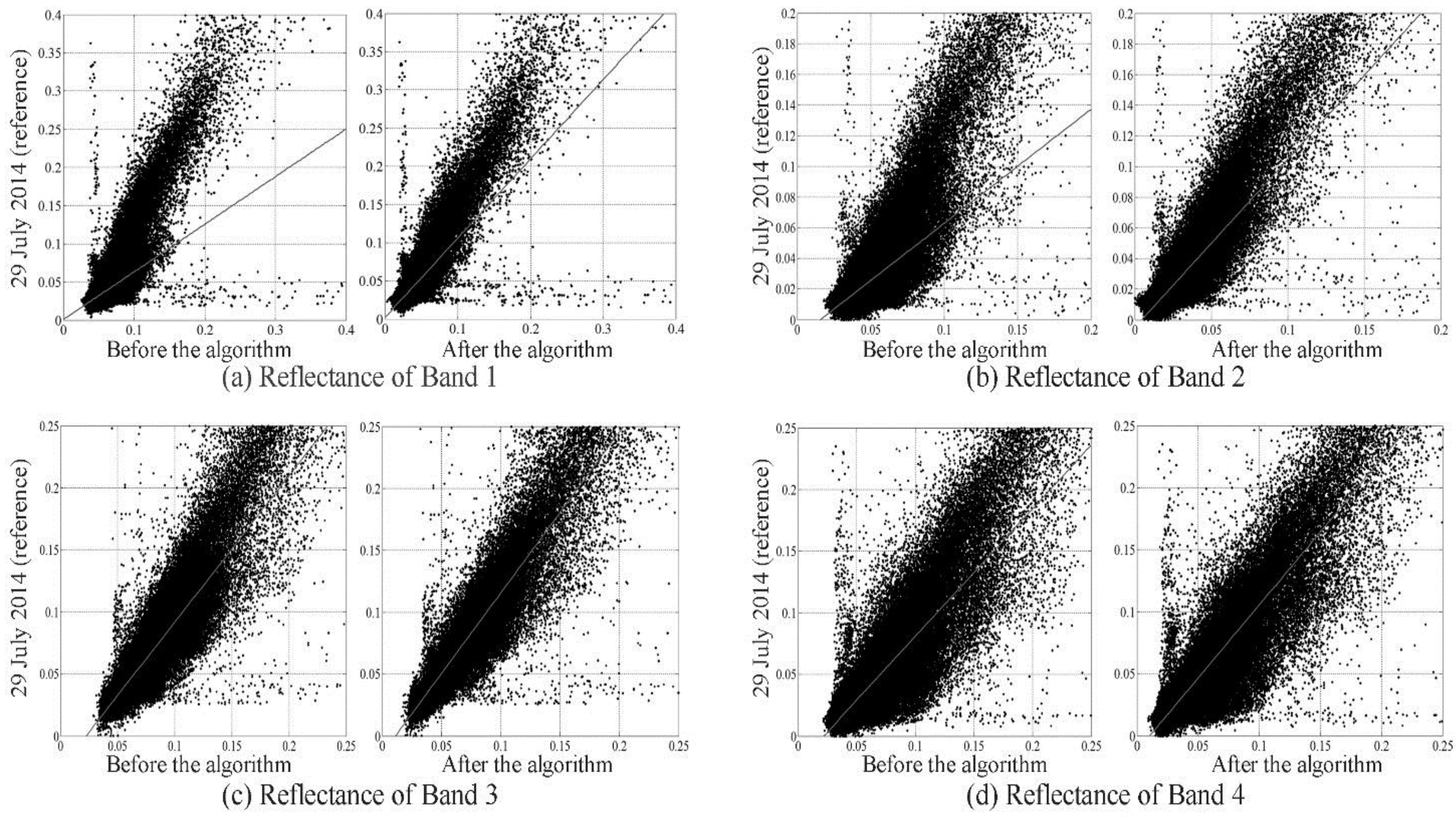

3.2.3. Assessment in Cloud-Free Areas
| Slope | Intercept | R2 | |
|---|---|---|---|
| Band 1 | 1.007 | 0.004 | 0.910 |
| Band 2 | 1.007 | 0.003 | 0.944 |
| Band 3 | 1.001 | 0.003 | 0.984 |
| Band 4 | 1.002 | 0.003 | 0.992 |
| Band 5 | 1.002 | –0.003 | 0.999 |
| Band 6 | 1.002 | –0.003 | 0.998 |
| Band 7 | 1.000 | –0.001 | 0.999 |
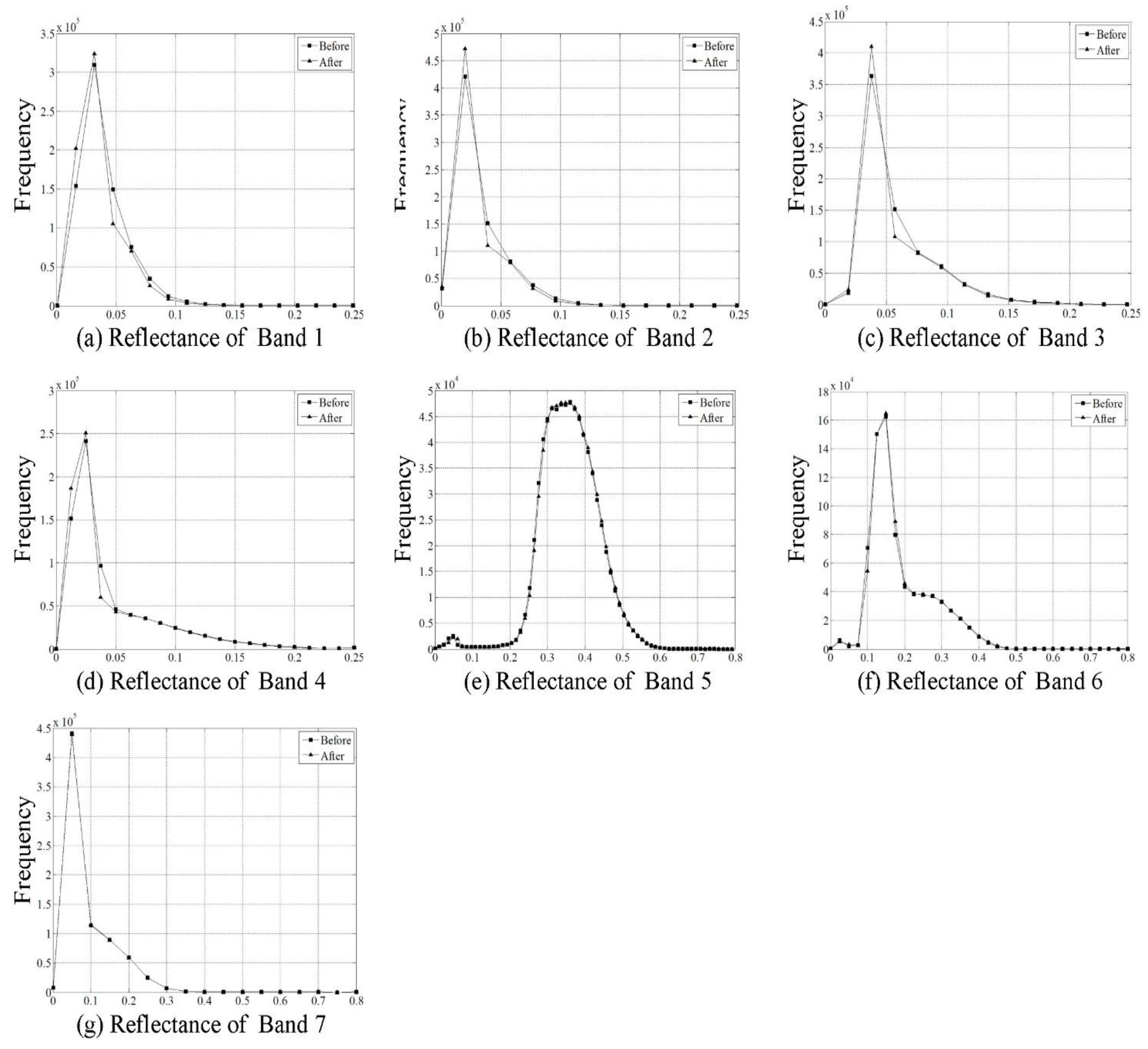
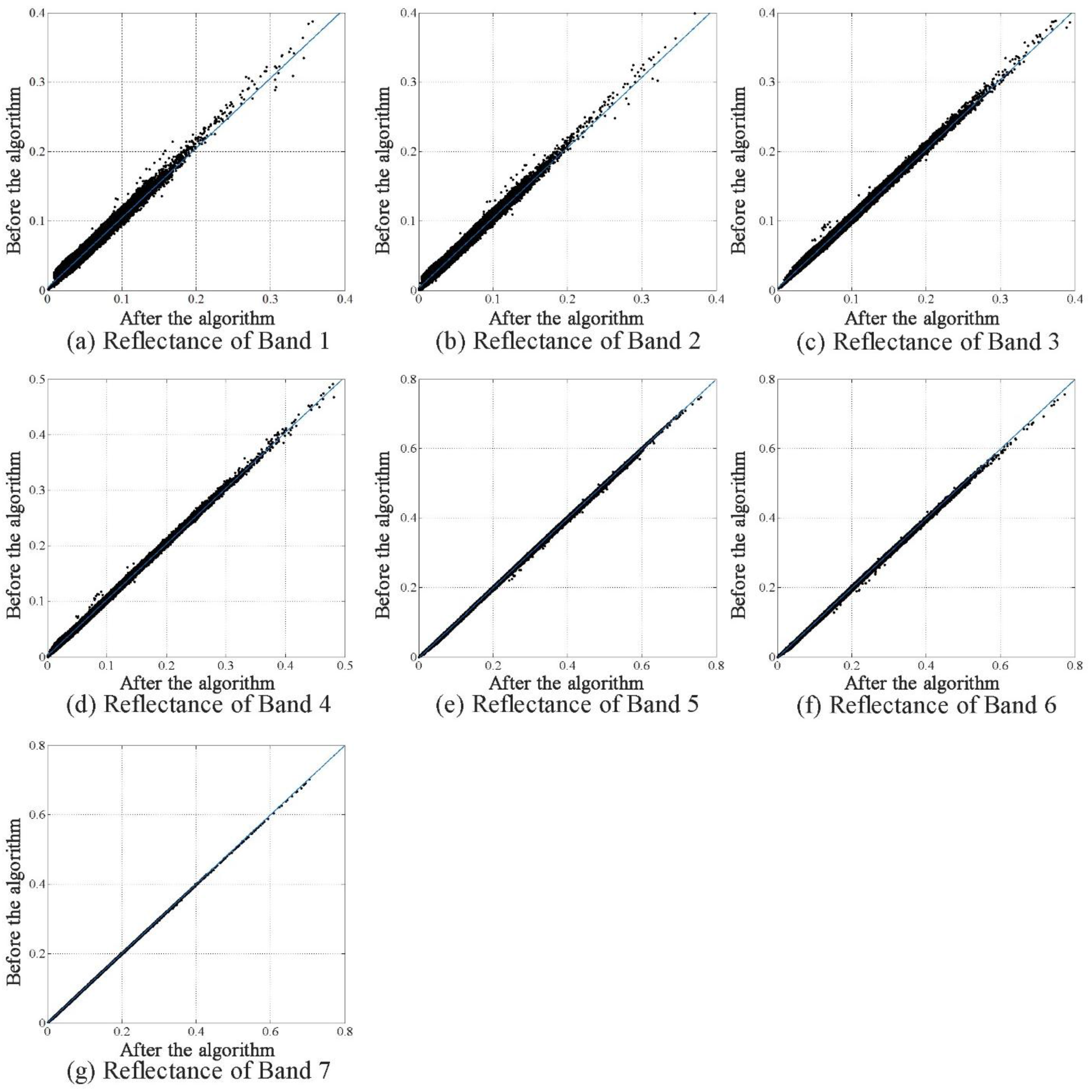
3.3. Applicability to Other LULC Types and to an Entire Landsat-8 Image
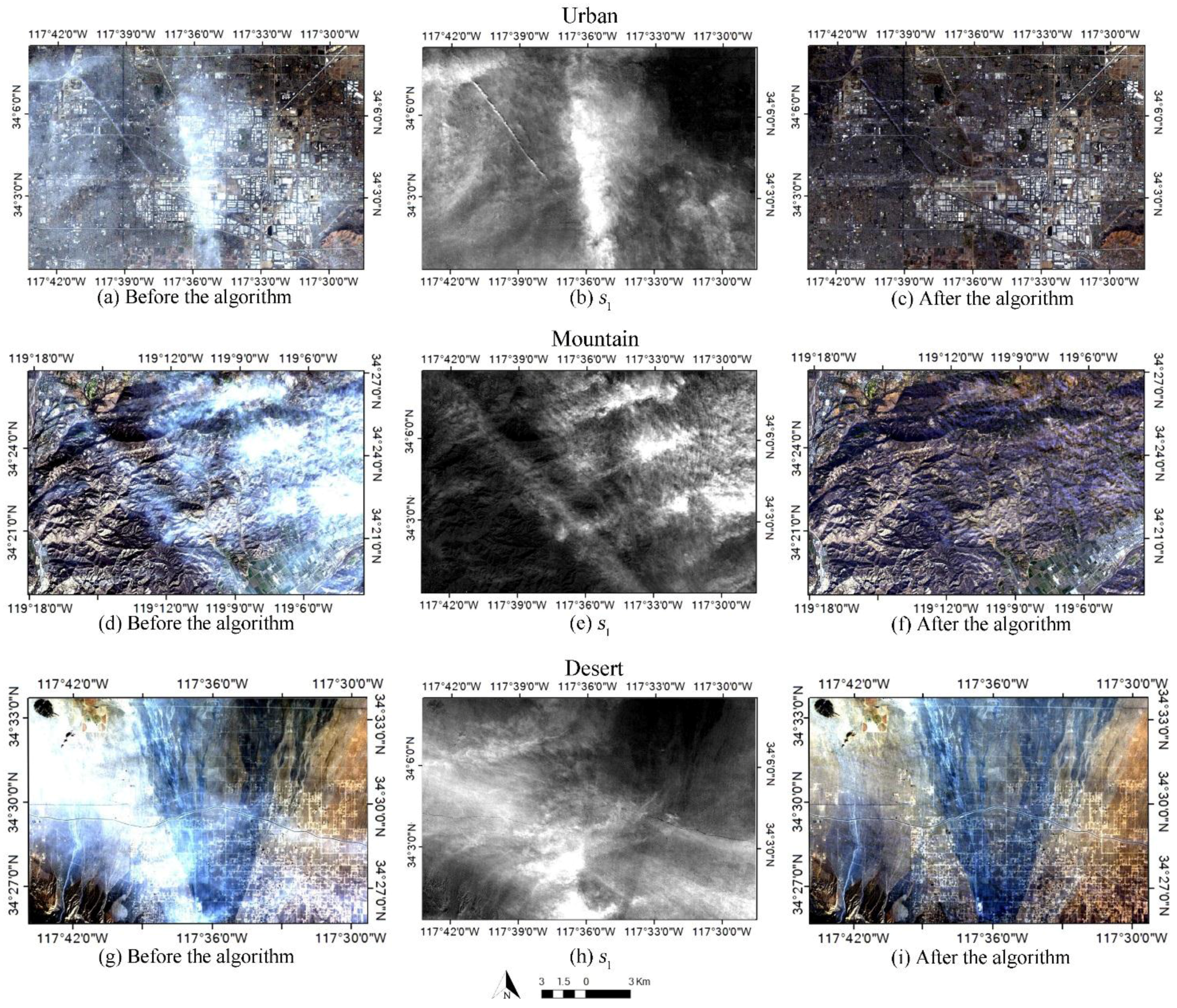
| Urban | Mountain | Desert | ||||
|---|---|---|---|---|---|---|
| Before | After | Before | After | Before | After | |
| Band 1 | 0.205 | 0.172 | 0.181 | 0.156 | 0.188 | 0.176 |
| Band 2 | 0.189 | 0.155 | 0.160 | 0.135 | 0.178 | 0.166 |
| Band 3 | 0.167 | 0.134 | 0.133 | 0.108 | 0.173 | 0.161 |
| Band 4 | 0.168 | 0.135 | 0.131 | 0.106 | 0.190 | 0.178 |
| Band 5 | 0.222 | 0.175 | 0.206 | 0.170 | 0.238 | 0.221 |
| Band 6 | 0.183 | 0.154 | 0.229 | 0.207 | 0.257 | 0.246 |
| Band 7 | 0.154 | 0.130 | 0.173 | 0.155 | 0.225 | 0.216 |
4. Conclusions
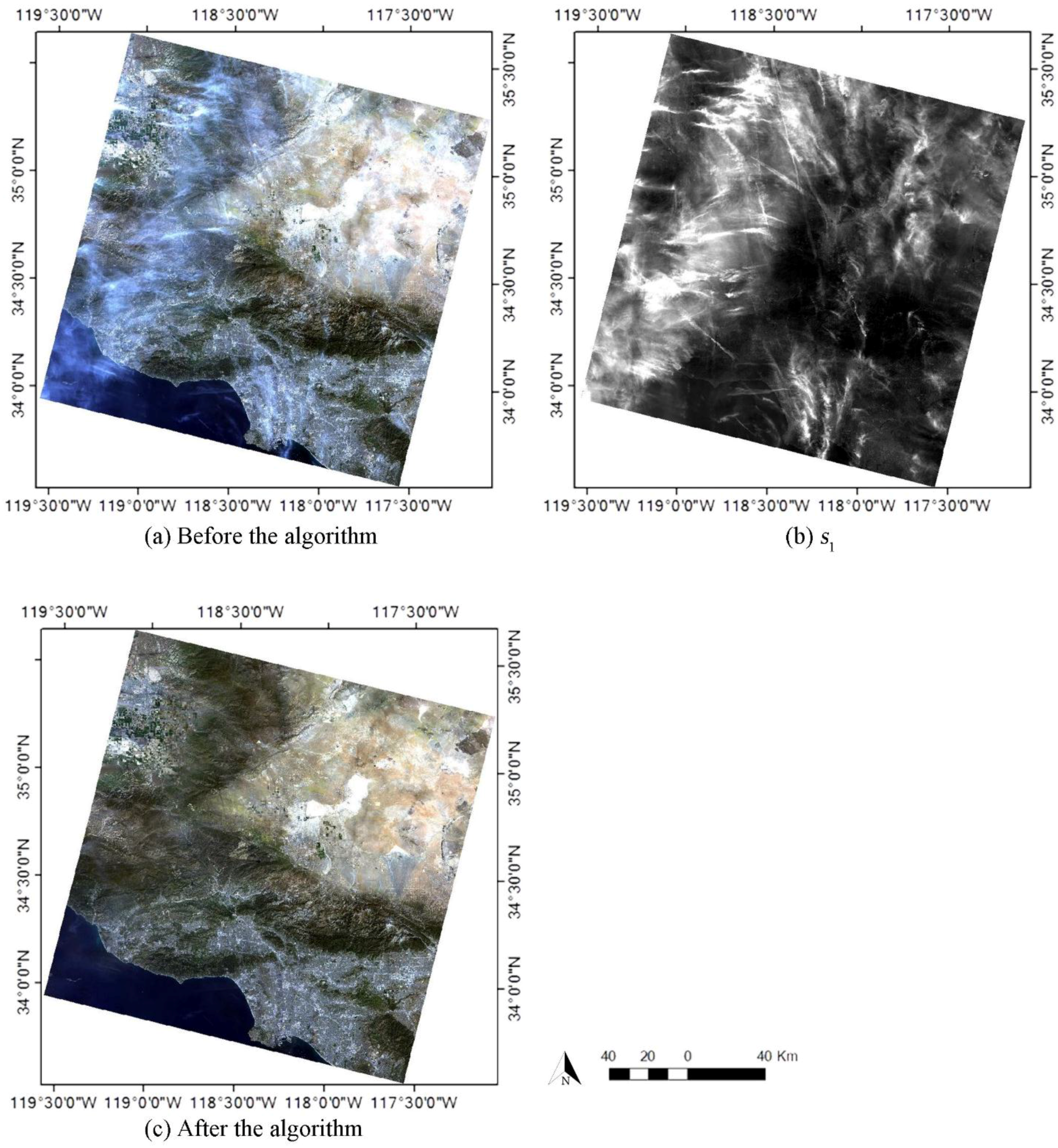
Acknowledgements
Author Contributions
Conflicts of Interest
References
- U.S. Geological Survey. Landsat—A global Land-Imaging Mission: U.S. Geological Survey fact sheet 2012–3072. Available online: http://pubs.usgs.gov/fs/2012/3072/ (accessed on 15 August 2015).
- Xu, M.; Jia, X.; Pickering, M. Automatic cloud removal for Landsat 8 OLI images using cirrus band. In Proceedings of the IEEE International Geoscience and Remote Sensing Symposium, Quebec City, QC, Canada, 13–18 July 2014; pp. 2511–2514.
- Shen, Y.; Wang, Y.; Lv, H.; Li, H. Removal of thin clouds using cirrus and QA bands of Landsat 8. Photogramm. Eng. Remote Sens. 2015, 81, 721–731. [Google Scholar] [CrossRef]
- Goodwin, N.R.; Collett, L.J.; Denham, R.J.; Flood, N.; Tindall, D. Cloud and cloud shadow screening across Queensland, Australia: An automated method for Landsat TM/ETM+ time series. Remote Sens. Environ. 2013, 134, 50–65. [Google Scholar] [CrossRef]
- Chanda, B.; Majumder, D.D. An iterative algorithm for removing the effect of thin cloud cover from LANDSAT imagery. Math. Geol. 1991, 23, 853–860. [Google Scholar] [CrossRef]
- Shen, H.; Li, H.; Qian, Y.; Zhang, L.; Yuan, Q. An effective thin cloud removal procedure for visible remote sensing Images. ISPRS J. Photogramm. Remote Sens. 2014, 96, 224–235. [Google Scholar] [CrossRef]
- Tseng, D.C.; Tseng, H.T.; Chien, C.L. Automatic cloud removal from multi-temporal SPOT images. Appl. Math. Comput. 2008, 205, 584–600. [Google Scholar] [CrossRef]
- Cheng, Q.; Shen, H.; Zhang, L.; Yuan, Q.; Zeng, C. Cloud removal for remotely sensed images by similar pixel replacement guided with a spatio-temporal MRF model. ISPRS J. Photogramm. Remote Sens. 2014, 92, 54–68. [Google Scholar] [CrossRef]
- Jin, S.; Homer, C.G.; Yang, L.; Xian, G.; Fry, J.; Danielson, P.; Townsend, P.A. Automated cloud and shadow detection and filling using two-date Landsat imagery in the USA. Int. J. Remote Sens. 2013, 34, 1540–1560. [Google Scholar] [CrossRef]
- Liu, J.; Wang, X.; Chen, M.; Liu, S.G.; Zhou, X.R.; Shao, Z.F.; Liu, P. Thin cloud removal from single satellite images. Opt. Express 2014, 22, 618–632. [Google Scholar] [CrossRef] [PubMed]
- Earth Observation Portal. Available online: https://directory.eoportal.org/web/eoportal/directory (accessed on 15 August 2015).
- Zhang, Y.; Guindon, B.; Cihlar, J. An image transform to characterize and compensate for spatial variations in thin cloud contamination of Landsat images. Remote Sens. Environ. 2002, 82, 173–187. [Google Scholar] [CrossRef]
- Kauth, R.J.; Thomas, G.S. The Tasseled Cap—A graphic description of the spectral-temporal development of agricultural crops as seen in Landsat. In Proceedings of the Landsat Symposium on Machine Processing of Remotely Sensed Data, West Lafayette, IN, USA, 29 June–1 July 1976; pp. 41–51.
- Li, H.; Zhang, L.; Shen, H. A principal component based haze masking method for visible images. IEEE Geosci. Remote Sens. Lett. 2013, 11, 975–979. [Google Scholar] [CrossRef]
- Crist, E.P.; Cicone, R.C. A physically-based transformation of Thematic Mapper data—The TM Tasselled Cap. IEEE Trans. Geosci. Remote Sens. 1984, 22, 256–263. [Google Scholar] [CrossRef]
- Lavreau, J. De-Hazing Landsat thematic mapper images. Photogramm. Eng. Remote Sens. 1991, 57, 1297–1302. [Google Scholar]
- Baig, M.H.A.; Zhang, L.; Tong, S.; Tong, Q. Derivation of a Tasselled Cap transformation based on Landsat 8 at-satellite reflectance. Remote Sens. Lett. 2014, 5, 423–431. [Google Scholar] [CrossRef]
- Liu, Q.; Liu, G.; Huang, C.; Xie, C. Comparison of Tasselled Cap transformations based on the selective bands of Landsat 8 OLI TOA reflectance images. IEEE Trans. Geosci. Remote Sens. 2015, 36, 417–441. [Google Scholar] [CrossRef]
- Miguel, M.; Carlos, J.G.; Horacio, G.; Ramón, G. Independent component analysis for cloud screening of Meteosat images. In Artificial Neural Nets Problem Solving Methods: 7th International Work-Conference on Artificial and Natural Neural Networks Proceedings, Part II; Springer: Berlin/Heidelberg, Germany, 2003; Volume 2687, pp. 551–558. [Google Scholar]
- Unger, H.; Zeevi, Y.Y. Blind separation of a dynamic image source from superimposed reflections. Proc. SPIE 2005, 5888. [Google Scholar] [CrossRef]
- Du, H.; Wang, Y.; Chen, Y. Studies on cloud detection of atmospheric remote sensing image using ICA algorithm. In Proceedings of the 2nd International Congress on Image and Signal Processing, Tianjin, China, 17–19 October 2009; pp. 1–4.
- Hyvärinen, A. Fast and robust fixed-point algorithms for independent component analysis. IEEE Trans. Neural Netw. 1999, 10, 626–634. [Google Scholar] [CrossRef] [PubMed]
- Hyvärinen, A.; Oja, E. Independent component analysis: algorithms and applications. Neural Netw. 2000, 13, 411–430. [Google Scholar] [CrossRef]
- Ozdogan, M. The spatial distribution of crop types from MODIS data: Temporal unmixing using Independent Component Analysis. Remote Sens. Environ. 2010, 114, 1190–1204. [Google Scholar] [CrossRef]
- Gao, B.; Yang, P.; Han, W.; Li, R.; Wiscombe, W.J. An algorithm using visible and 1.38-μm channels to retrieve cirrus cloud reflectances from aircraft and satellite data. IEEE Trans. Geosci. Remote Sens. 2002, 40, 1659–1668. [Google Scholar]
- Ji, C.Y. Haze reduction from the visible bands of Landsat TM and ETM+ images over a shallow water reef environment. Remote Sens. Environ. 2008, 112, 1773–1783. [Google Scholar] [CrossRef]
- Li, C.F.; Yin, J.Y. Variational Bayesian independent component analysis-support vector machine for remote sensing classification. Comput. Elect. Eng. 2013, 39, 717–726. [Google Scholar] [CrossRef]
- Gao, B.; Li, R. Removal of thin cirrus scattering effects for remote sensing of ocean color from space. IEEE Geosci. Remote Sens. Lett. 2012, 9, 972–976. [Google Scholar]
- U.S. Geological Survey. Landsat 8 Quality Assessment band. Available online: https://landsat.usgs.gov/L8QualityAssessmentBand.php (accessed on 15 August 2015).
- Zhu, Z.; Woodcock, C.E. Object-based cloud and cloud shadow detection in Landsat imagery. Remote Sens. Environ. 2012, 118, 83–94. [Google Scholar] [CrossRef]
© 2015 by the authors; licensee MDPI, Basel, Switzerland. This article is an open access article distributed under the terms and conditions of the Creative Commons Attribution license (http://creativecommons.org/licenses/by/4.0/).
Share and Cite
Shen, Y.; Wang, Y.; Lv, H.; Qian, J. Removal of Thin Clouds in Landsat-8 OLI Data with Independent Component Analysis. Remote Sens. 2015, 7, 11481-11500. https://doi.org/10.3390/rs70911481
Shen Y, Wang Y, Lv H, Qian J. Removal of Thin Clouds in Landsat-8 OLI Data with Independent Component Analysis. Remote Sensing. 2015; 7(9):11481-11500. https://doi.org/10.3390/rs70911481
Chicago/Turabian StyleShen, Yang, Yong Wang, Haitao Lv, and Jiang Qian. 2015. "Removal of Thin Clouds in Landsat-8 OLI Data with Independent Component Analysis" Remote Sensing 7, no. 9: 11481-11500. https://doi.org/10.3390/rs70911481
APA StyleShen, Y., Wang, Y., Lv, H., & Qian, J. (2015). Removal of Thin Clouds in Landsat-8 OLI Data with Independent Component Analysis. Remote Sensing, 7(9), 11481-11500. https://doi.org/10.3390/rs70911481





